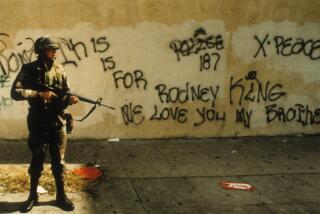Tottenham riots: Violence may be contagious in London, but so is altruism
- Share via
The violence that erupted in the low-income London neighborhood of Tottenham after police shot and killed 29-year-old Mark Duggan last weekhas quickly spread to other areas, reportedly devolving from political statement to unchecked criminality, according to a KPCC story on the riots this morning.
“Croydon was on fire last night,” BBCreporter Anita Anand told Madeleine Brand Tuesday morning.
“There was a stretch of road I drove down where not a single shop wasn’t being looted,” she said of one South London neighborhood hard-hit by wide-scale violence that has left more than 500 arrested, at least 58 injured and one dead. “There were cars being set on fire in the middle of the street. ... People were chancing their luck to see what they could carry out of stores,” she added.
But, Anand pointed out, there were also people in and around these hard-hit neighborhoods who were coming out to clean up the mess every day, spreading the word via social networks such as Twitter.
Are crowds just as susceptible to altruistic tendencies as they are to violent ones? Two researchers from UC San Diego and Harvard thought so. They tested the theory by studying participants’ behavior in a “public goods” game in which one player could share points with other players at a cost to himself.
They found the recipients would then pass points on to other players -- whom they had not even met and did not play twice -- even though they did not have to, and it cost them personally to do so.
This altruism continued over several degrees of separation from the original points-sharing player, and persisted over time -- recipients of a single kindness continued sharing with others over multiple turns in the game.
“Each additional contribution a subject makes to the public good in the first period is tripled over the course of the experiment by other subjects who are directly or indirectly influenced to contribute more as a consequence,” the authors wrote.
The results, published in 2010 in the journal Proceedings of the National Academy of Sciences, provide some hope that crowds might be just as susceptible to contagious positive behaviors as they are to negative ones.
Follow me on Twitter @LAT_aminakhan.
More to Read
Sign up for Essential California
The most important California stories and recommendations in your inbox every morning.
You may occasionally receive promotional content from the Los Angeles Times.











